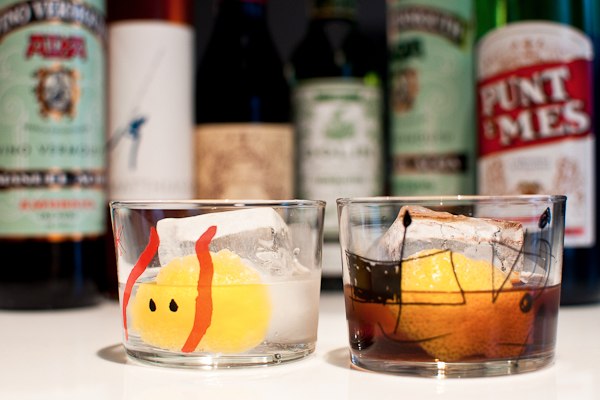Vermouth - Find. Eat. Drink.
Vermouth, Sweet, Dry, Aperitif, French, Italian, Spanish, USA, American, California, France, Spain, Italy, United States, Napa Valley, New York, Brooklyn, Extra Dry, Atxa, Matthiasson, Massican, Carpano Antica Formula, Punt e Mes, Dolin, Uncouth Vermouth, Atsby Vermouth, Mauro Vergano Bianco Vermouth, Martini & Rossi, Quady Vya, Cocktails, Low Alcohol Cocktails, Martini, Manhattan, Drinks, Aperitif, Aperitivo, What to drink before a Meal, Bartenders Recommendations, Wine Importers Recommendations, The Best Vermouths, Which Vermouths To Use













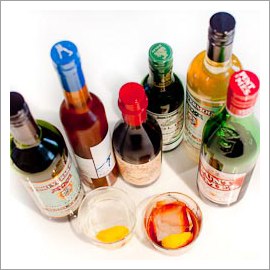
A couple of years ago we wrote a column on Find. Eat. Drink. and said that “despite being around since the late 1700s, vermouth suffers from always being a bridesmaid and never a bride.” This is finally changing and vermouth is having its day.
Whether you are drinking vermouth in a classic aperitif-style on the rocks with twist, having a vermouth and sherry cocktail, or looking to try some variations on a classic martini or Manhattan, now is an ideal time to explore vermouth landscape.
June 25, 2014
Vermouth Gets a Leading Role

Share

Photo Credit: Find. Eat. Drink.
Share


A couple of years ago we wrote a column on Find. Eat. Drink. and said that “despite being around since the late 1700s, vermouth suffers from always being a bridesmaid and never a bride.” This is finally changing and vermouth is having its day. A few factors are helping vermouth gain more presence in the spotlight, one being that more and more interesting old school style vermouths are being imported into the U.S. market; American-made vermouths are also populating the shelves of bars and liquor stores; and the cocktail scene is embracing lower alcohol drinks.
Whether you are drinking vermouth in a classic aperitif-style on the rocks with a twist, having a vermouth and sherry cocktail, or looking to try some variations on a classic martini or Manhattan, now is an ideal time to explore vermouth landscape.
Vermouth: A Brief Introduction
Vermouths are fortified aromatized wines. A wine base is fortified by adding a neutral spirit (in most cases a grape brandy) and aromatized through the infusion and distillation of botanicals, including roots, barks, flowers, seeds, herbs, and spices. Vermouth actually comes from the French pronunciation of the German wermut which means wormword, one of the botanicals used in the production of vermouth. The color of the vermouth does not result from the wine used, but as a result of the botanicals used.

Storage
When was the last time you bought a bottle of vermouth? If you can’t remember or your answer is that it was longer than a month, your first step in enjoying vermouth as a aperitif is to throw out the bottle that’s been sitting in your cupboard for far too long and buy a new one.
Vermouth needs to be treated more like a wine than a spirit or liqueur. Imagine drinking a glass of wine from a bottle that has been open for six months. To get the full enjoyment of vermouth, you want that freshness and brightness of flavors. Buy half bottles (where you can), keep them in the fridge, and use them within a matter of weeks. It’s an ideal excuse to cycle through a variety of vermouths.
Vermouth: A Perfect Aperitif
From a cocktail perspective, the traditional way of using vermouth is to mix in a French dry vermouth like Noilly Prat or Dolin in a martini and an Italian sweet vermouth like Cinzano, Martini & Rosso, or Carpano in a Manhattan and Negroni. Try upping the vermouth ratio in your favorite martini to beyond a wisp and you’ll be pleasantly surprised.

The even more traditional way of enjoying vermouth though is as a simple aperitif on the rocks with a twist. It’s a classic aperitif that enlivens your palate and it won’t get the party started too quickly.
Or split the difference and make vermouth cocktails. The folks at Vya, a California vermouth producer showcase their vermouths in a Vya cocktail, which is two thirds dry vermouth and one third sweet vermouth. Bartender Naren Young at Bacchanal has a whole aperitif cocktail section that includes the Adonis, which is made with Noilly Prat Ambre, Amontillado sherry, and orange bitters; and the Improved & Fancy with Dolin Dry, Maraschino, Pernod absinthe, and lemon bitters. There are so many possibilities. Alex Wallace created the Lab 220 using two Spanish vermouths from Atxa with their Vino Vermouth Rojo, Vino Vermouth Blanco, and Fino Sherry.

Try These Vermouths
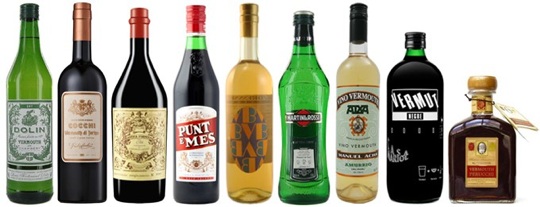
Old School Vermouths
While these are the more traditional styles of vermouth produced in Europe, it doesn’t mean they all taste the same. There is a whole range of flavors and styles here to meet everyone’s tastes and uses.
French | Dolin (Dry, Blanc, Rouge)
One of the benchmark French vermouth producers and the last remaining producers of vermouth in the city Chambéry in the Savoie. Their style is lighter, drier and less pungent than other producers. Dolin blanc is a sweet white vermouth which is more herb than spice-focused. Bartender Naren Young (Bacchanal) calls them, “beautiful vermouths.” [Buy]
Italian | Cocchi Vermouth di Torino (Sweet)
Cocchi revived their original recipe vermouth production in 2011 and is the only vermouth with the designation Vermouth di Torino. Moscato wine is the base and cocoa, citrus, and rhubarb are among the botanicals used. It’s a full flavored vermouth with notes of orange zest, vanilla, mint and anise. [Buy]
Italian | Carpano (Sweet)
Carpano produces a full range of vermouths, but two worth looking out for is the Antica Formula and the Punt e Mes. The Antica Formula bottle just looks like a classic sweet vermouth bottle should look like. It was first introduced in 1990 and is based on an old recipe, but not the original recipe. It’s a very rich and dark vermouth, possibly more wintery than summery, and bartender Naren Young (Bacchanal) describes them as “big, bold, and viscous with spices and vanilla.” Punt e Mes is another richer-style vermouth, but less so that the Antica Formula with flavors of herbs, cloves, orange and toffee. [Buy Antica Formula / Buy Punt e Mes]
Italian | Mauro Vergano Bianco (Sweet)
Mauro Vergano was by trade a trained chemist and oenologist, but he loved chinato. To create his bianco vermouth, Mauro uses a base of dry Moscato and Cortese wines and a mixture of herbs (thyme, marjoram, basil, oregano) along with other botanicals to create a light yellow vermouth that is sweet, bitter, and fragrant. [Buy]
Italian | Martini & Rossi (Dry, Sweet)
Bartender Naren Young calls Martini & Rossi one of the vermouth benchmarks. He’s responsible for the bar program at the newly opened Bacchanal and he has Martini and Rossi Dry on tap. “We serve it in a beautiful goblet with as spritzer with frozen grapes that act as the ice cubes, topped with a little Perrier and garnished with a lemon twist. It’s a nice way to start a meal.” [Buy]
Spanish | Atxa Vino Vermouth (Blanco, Rojo)
The Atxa vermouths are made using old recipes that have been passed down through the generations of the Acha family in the Basque Country since 1831. The Blanco’s botanicals include wormwood, gentian and bitter orange and it displays fresh, flora characteristics with a balance of bitter and sweetness. The Rojo is also made with wormwood and gentian, but with cherry instead of bitter orange. It has notes of licorice and wild herbs with berry fruits and a bitterness. Importer André Tamers says, “It’s a traditional recipe and they are meant to be sipped on their own with a garnish.” Producer Gabriel Acha notes, “It’s all about waking up your appetite and downing these with some olives or banderillas [Spanish appetizers].” [Buy]
Spanish | Casa Mariol Vermut Negre (Sweet)
Produced in Terra Alta in Spain, it’s a dark brown, mahogany, rich vermouth made from Macabeu wine with unripe green walnuts, spices, and local herbs from Matarraña area of Spain that is aged in wood. It has lots of herbal notes like thyme and rosemary, along with spice, a bitterness balanced with a sweetness. [Buy]
Spanish | Perucchi (Rojo, Blanco)
From Cataluña, Spain, produced since the 19th century. This was the first vermouth produced in Spain and they are still using the same tubs, presses and casks to make the vermouth today. It started coming into the US in a little over 4 years ago. The Blanco is a spicy sweet version with notes of ginger and honey and the Rojo is bitter, earthy and woody with Christmas spices. [Buy]
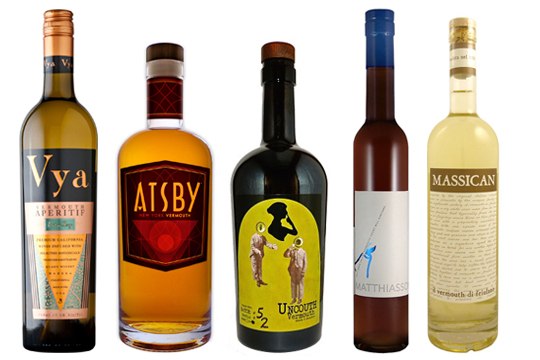
New School Vermouths
These are the new(er) kids on the block. They are the upstarts that are causing the old school brands to wince a bit. Whereas the European vermouth makers are somewhat constrained by law and must include wormwood in their ingredients, the American vermouth produces are not limited by the rules. Some are more classically styled, such as the Vya vermouths, but others are taking on a whole new approach and flavor profile, such as Uncouth Vermouth.
American | Quady Vya (Whisper Dry, Extra Dry, Sweet)
Of this group of new school vermouths, this is the grandfather of the bunch. Andrew Quady started making vermouth in California’s Central Valley in 1999. All the vermouths use wine made from the Orange Muscat as the base. They make two dry styles with the Whisper Dry vermouth being the most delicate, softer and less herbaceous than the Extra Dry and is intended for the martini to be paired with gin and vodka. The Extra Dry is a more powerful dry vermouth with herbaceous notes. In addition to the Orange Muscat, Tinta Roriz is also blended into the sweet vermouth. It’s a combination of bitter, sweet, warmth from spices. [Buy]
American | Atsby (Amberthorn, Armadillo Cake)
This is an East Coast vermouth made in New York state. Both vermouths use North Fork chardonnay as the base and are fortified with apple brandy. There is an apple quality to both than comes through the herbs and spices. The Amberthorn is made with anise, lavender, and basil and is a rich, aromatic vermouth. Not to be pigeon-holed by old descriptors like dry and sweet, this is a “summer-honey-colored vermouth” and is the lighter of the two. The Armadillo Cake is made with dark caramel with herbs and bark as well as less traditional ingredients. It’s a more spicy vermouth. [Buy]
American | Uncouth Vermouth
Of the new school bunch, Uncouth Vermouth is the one that is really pushing the boundaries of vermouth. Bianca Miraglia makes her vermouths in Red Hook and was hit hard by hurricane Sandy. She’s committed to producing sustainably-focused vermouths using ingredients that are foraged or purchased from farms. She doesn’t add sugar or preservatives either and any sweetness in her vermouths come from wine or fruit. Her unique flavors vermouths include: Apple Mint, Pear Ginger, Butternut Squash, Beet Eucalyptus, Serrano Chile Lavender. There are no rules in using these vermouths. [Buy]
American | Matthiasson Napa Valley Vermouth
Winemaker Steve Matthiasson’s vermouth came from a problematic few barrels of wine (made from the Flora grape) that over-fermented. He added blood orange zest, cardoons, and sour cherries from his garden, as well as coriander, cardoons, chinchona bark, wormwood, and blessed thistle to create the aperitif he had been dreaming about making for years. He describes it as “a sweet Italian-style vermouth.” [Buy]
American | Massican Vermouth di Friulano
Winemaker Dan Petroski at Massican winery in Napa first made a vermouth with the 2011 vintage and liked it so much he added to the lineup. He uses barrel-aged Tocai Friulano as the base along with Indian coriander, orange peel, lemon rind, nutmeg and quassia wood. It’s floral and herbal vermouth. [Buy]
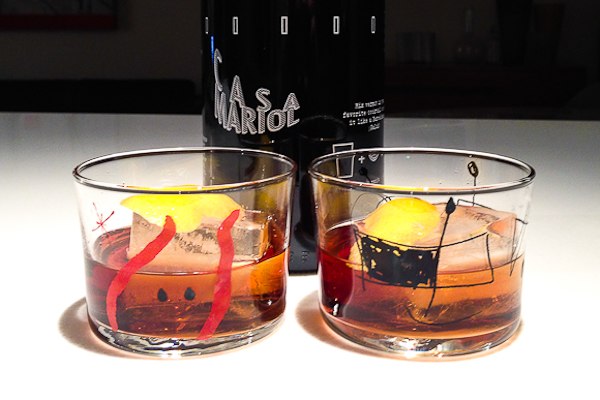
Casa Mariol Vermut Negre on ice with a twist
Photo Credit: Find. Eat. Drink.
Enjoying Vermouth
Keeping It Simple
The consistent approach to enjoying all these vermouths is over ice with a twist. Beyond that there are some simple variations and recommendations. Importer André Tamers recommends adding a drop or two of gin to the Atxa Blanco with a slice of lemon, and a drop of Campari and an olive or orange slice to the Rojo. He notes that the olive adds a salty component which is critical.
Mauro Vergano suggests trying his Vermouth Bianco chilled or with ice cubes, a zest of lemon, with sparkling water.
Dan Petroski recommends enjoying his Massican vermouth simply over ice with a dash of orange bitters and a lemon twist.
Slightly More Complicated
Try these vermouth-focused cocktails as a start to your meal.
The Vya (Recipe courtesy of Vya Vermouth)
Add 2/3 oz. of Vya Extra Dry Vermouth with 1/3 oz. Vya Sweet Vermouth over ice in a Old Fashioned glass and add a twist of lemon or orange.
Lab 220 (Recipe courtesy of De Maison Selections and Alex Wallace)
Over ice in a rocks glass, stir together 2 oz. Atxa Vino Vermouth Rojo, 1 oz. Atxa Vino Vermouth Blanco, 1 oz. Fino Sherry, and garnish with an orange wedge.
Board of Directors (Recipe courtesy of bartender Mike Ryan)
Shake over ice, 2 oz. Noilly Prat Dry Vermouth, 1/4 oz. Green Chartreuse, 1/4 oz. fresh lemon juice, 1/4 oz. honey syrup (2:1 ratio of honey and water), and strain into a chilled cocktail coupe.
Follow Us




Follow Us

